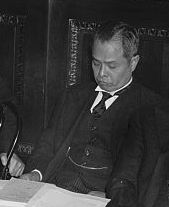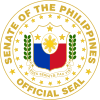Camilo Osías
This article needs additional citations for verification. (November 2024) |
Camilo Osías | |
|---|---|
 | |
| 6th President of the Senate of the Philippines | |
| In office April 30, 1953 – May 20, 1953 | |
| Preceded by | Eulogio Rodriguez |
| Succeeded by | Jose Zulueta |
| In office April 17, 1952 – April 30, 1952 | |
| Preceded by | Quintin Paredes |
| Succeeded by | Eulogio Rodriguez |
| Senator of the Philippines | |
| In office December 30, 1947 – December 30, 1953 | |
| In office December 30, 1961 – December 30, 1967 | |
| In office 1925–1929 | |
| Preceded by | Bernabé de Guzmán |
| Succeeded by | Alejandro de Guzmán |
| Constituency | 2nd district |
| Minister of Education | |
| In office October 1943 – February 1945 | |
| President | José P. Laurel |
| Preceded by | Claro M. Recto |
| Member of the Philippine National Assembly from La Union's 1st district | |
| In office November 15, 1935 – 1938 | |
| Preceded by | Francisco Ortega |
| Succeeded by | Delfin Flores |
| Resident Commissioner to the U.S. House of Representatives from the Philippine Islands | |
| In office March 4, 1929 – January 3, 1935 Serving with Pedro Guevara | |
| Preceded by | Isauro Gabaldon |
| Succeeded by | Francisco A. Delgado |
| Personal details | |
| Born | Camilo Osías y Olaviano March 23, 1889 Balaoan, La Union, Captaincy General of the Philippines |
| Died | May 20, 1976 (aged 87) Manila, Philippines |
| Political party | Liberal (1953–1976) |
| Other political affiliations | KALIBAPI (1942–1945) Nacionalista (1925–1942; 1947–1953) |
| Spouse(s) | Ildefonza Cuaresma Avelina Lorenzana |
| Children | 6 |
| Alma mater | University of Chicago Western Illinois University Columbia University |
Camilo Olaviano Osías Sr. (born Camilo Osías y Olaviano; March 23, 1889 – May 20, 1976), was a Filipino politician, twice for a short time President of the Senate of the Philippines. Along with American Mary A. Lane, Osías translated into English the poem Filipinas that was set to the Marcha Nacional Filipina, producing the Philippine Hymn, now the national anthem Lupang Hinirang.
Biography
[edit]Early life and education
[edit]Osías attended school in Balaoan, Vigan and San Fernando, and was selected a government scholar to the United States in 1905. He studied at the University of Chicago in 1906 and 1907. He graduated from the Western Illinois State Teachers College at Macomb, Illinois in 1908, and from the Teachers College of Columbia University in New York City in 1910.[1]
Early career
[edit]On his return to the Philippines, he taught and later assumed various administrative positions, particularly in the field of education. He successively became the first Filipino Superintendent of Schools (1915 to 1916), Assistant Director of Education (1917 to 1921), a lecturer at the University of the Philippines (1919 to 1921), and President of National University (1921–1936), a private institution.[2]
Political career
[edit]Osías then entered national politics. He was a member of the first Philippine mission to the United States (1919 to 1920). He was elected to the Philippine Senate in 1925, and as a Nacionalista, was Resident Commissioner in the United States House of Representatives in 1928, reelected in 1931 and served from March 4, 1929 until January 3, 1935, when his term expired in accordance with the new government of the Philippine Commonwealth. In 1934, he was an unsuccessful candidate for election to the Philippine Senate, but became a member of the Constitutional Convention in 1934, and a member of the first National Assembly in 1935.[3] In 1939, he was a member of the Economic Mission to the United States, and chairman of the Educational Mission between 1938 and 1941.

Back in the Philippines, Osías became chairman of the National Council of Education in 1941, Director of Publicity and Propaganda until January 1942, chairman of the National Cooperative Administration in 1941, later Assistant Commissioner of the Department of Education, Health, and Public Welfare, then Secretary of Education until 1945. He was also Chancellor of Osías Colleges. He was elected again to the Philippine Senate in 1947 for a term expiring in 1953. He was President of the Senate of the Philippines twice for a short time in 1952 and in 1953. He was the Philippines' representative to the Inter-Parliamentary Union in Rome and to the International Trade Conference in Genoa in 1948. He ran for reelection in 1953, but lost and again in 1955. He was elected again, this time as a Liberal to the Philippine Senate (1961–1967), and served as president pro tempore. He was a resident of Mandaluyong, Rizal (since incorporated into Metro Manila), until his death.
Presidential nomination
[edit]On April 12, 1953, Osias, being a prominent figure in the Nacionalista Party, lost the presidential nomination to Ramon Magsaysay at the Nacionalista Convention. Despite his experience and contributions to the party, Osias faced challenges due to his religious affiliation, being a Protestant to a Catholic-majority country, and the overwhelming popularity of Magsaysay. Feeling disrespected and defeated, Osias eventually switched to the Liberal Party.[4]
Personal life
[edit]Osías was married to Ildefonsa Cuaresma, a former public school teacher from Bacnotan, near his hometown, in 1914. The couple raised seven children, Camilo Jr., Salvador, Victor, Apolinario, Rebecca, Benjamin and Rosita. After more than 20 years of marriage, Camilo divorced Ildefonsa and married Avelina Lorenzana in Reno, Nevada. That marriage produced no children.
Bibliography
[edit]- Camilo Osías: The Story of a Long Career of Varied Tasks (Manlapaz Publishing Co., Quezon City, 1971)
- Eduardo Bananal: Camilo Osías: Educator and Statesman (Manlapaz Publishing Co., Quezon City, 1974)
- Camilo Osia (sic) in Hispanic Americans in Congress, 1822-1995, prepared under the direction of the Joint Committee on Printing by Carmen E. Enciso and Tracy North, Hispanic Division, Library of Congress (Government Printing Office, Washington, 1995)
See also
[edit]- List of Asian Americans and Pacific Islands Americans in the United States Congress
- Resident Commissioner of the Philippines
References
[edit]- ^ "OSIAS, Camilo". Biographical Directory of the United States Congress. Retrieved November 20, 2024.
- ^ Hallwas, John (January 14, 2013). "Camilo Osias and Macomb's forgotten sister city". The McDonough County Voice. Retrieved November 20, 2024.
- ^ Cruz Araneta, Gemma (April 7, 2022). "Reading with Camilo Osias". Manila Bulletin. Retrieved November 20, 2024.
- ^ Thomas, M. Ladd (1954). "Personalized Politics: Filipino Style". India Quarterly. 10 (4): 371–376. ISSN 0974-9284.
External links
[edit]- United States Congress. "Camilo Osías (id: O000118)". Biographical Directory of the United States Congress.
![]() This article incorporates public domain material from the Biographical Directory of the United States Congress
This article incorporates public domain material from the Biographical Directory of the United States Congress
- 1889 births
- 1976 deaths
- Filipino Methodists
- Ilocano people
- Filipino Protestants
- Converts to Protestantism from Roman Catholicism
- Laurel administration cabinet members
- Liberal Party (Philippines) politicians
- Members of the House of Representatives of the Philippines from La Union
- Members of the United States Congress of Filipino descent
- Members of the United States House of Representatives of Asian descent
- Nacionalista Party politicians
- People from La Union
- Filipino Freemasons
- Presidents of the Senate of the Philippines
- Quezon administration personnel
- Resident commissioners of the Philippines
- Secretaries of education of the Philippines
- Senators of the 1st Congress of the Philippines
- Senators of the 2nd Congress of the Philippines
- Senators of the 5th Congress of the Philippines
- Senators of the 6th Congress of the Philippines
- Senators of the 7th Philippine Legislature
- Senators of the 8th Philippine Legislature
- Teachers College, Columbia University alumni
- Western Illinois University alumni
- Members of the National Assembly of the Philippines
- KALIBAPI politicians
- Burials at the Loyola Memorial Park
- Filipino expatriates in the United States
- Members of the Senate of the Philippines from the 2nd district

